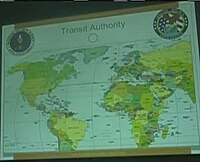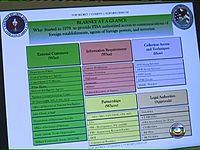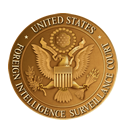
The United States Foreign Intelligence Surveillance Court (FISC), also called the FISA Court, is a U.S. federal court established under the Foreign Intelligence Surveillance Act of 1978 (FISA) to oversee requests for surveillance warrants against foreign spies inside the United States by federal law enforcement and intelligence agencies.
Project SHAMROCK was the sister project to Project MINARET, an espionage exercise started in August 1945. Project MINARET involved the accumulation of all telegraphic data that entered or exited the United States. The Armed Forces Security Agency (AFSA) and its successor, the National Security Agency (NSA), were given direct access to daily microfilm copies of all incoming, outgoing, and transiting telegrams via the Western Union and its associates RCA and ITT. NSA did the operational interception, and, if there was information that would be of interest to other intelligence agencies, the material was passed to them. Intercepted messages were disseminated to the FBI, CIA, Secret Service, Bureau of Narcotics and Dangerous Drugs (BNDD), and the Department of Defense. No court authorized the operation and there were no warrants.

NSA warrantless surveillance — also commonly referred to as "warrantless-wiretapping" or "-wiretaps" — was the surveillance of persons within the United States, including U.S. citizens, during the collection of notionally foreign intelligence by the National Security Agency (NSA) as part of the Terrorist Surveillance Program. In late 2001, the NSA was authorized to monitor, without obtaining a FISA warrant, phone calls, Internet activities, text messages and other forms of communication involving any party believed by the NSA to be outside the U.S., even if the other end of the communication lays within the U.S.

The FISA Amendments Act of 2008, also called the FAA and Foreign Intelligence Surveillance Act of 1978 Amendments Act of 2008, is an Act of Congress that amended the Foreign Intelligence Surveillance Act. It has been used as the legal basis for surveillance programs disclosed by Edward Snowden in 2013, including PRISM.
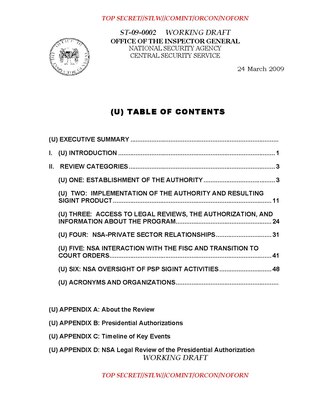
"Stellar Wind" was the code name of a warrantless surveillance program begun under the George W. Bush administration's President's Surveillance Program (PSP). The National Security Agency (NSA) program was approved by President Bush shortly after the September 11, 2001 attacks and was revealed by Thomas Tamm to The New York Times in 2004. Stellar Wind was a prelude to new legal structures that allowed President Bush and President Barack Obama to reproduce each of those programs and expand their reach.
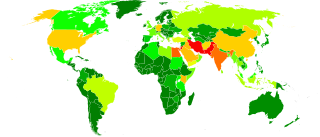
PRISM is a code name for a program under which the United States National Security Agency (NSA) collects internet communications from various U.S. internet companies. The program is also known by the SIGAD US-984XN. PRISM collects stored internet communications based on demands made to internet companies such as Google LLC and Apple under Section 702 of the FISA Amendments Act of 2008 to turn over any data that match court-approved search terms. Among other things, the NSA can use these PRISM requests to target communications that were encrypted when they traveled across the internet backbone, to focus on stored data that telecommunication filtering systems discarded earlier, and to get data that is easier to handle.

Boundless Informant is a big data analysis and data visualization tool used by the United States National Security Agency (NSA). It gives NSA managers summaries of the NSA's worldwide data collection activities by counting metadata. The existence of this tool was disclosed by documents leaked by Edward Snowden, who worked at the NSA for the defense contractor Booz Allen Hamilton. Those disclosed documents were in a direct contradiction to the NSA's assurance to United States Congress that it does not collect any type of data on millions of Americans.
Special Source Operations (SSO) is a division in the US National Security Agency (NSA) which is responsible for all programs aimed at collecting data from major fiber-optic cables and switches, both inside the US and abroad, and also through corporate partnerships. Its existence was revealed through documents provided by Edward Snowden to media outlets in 2013 and, according to him, it is the "crown jewel" of the NSA.

Fairview is a secret program under which the National Security Agency cooperates with the American telecommunications company AT&T in order to collect phone, internet and e-mail data mainly of foreign countries' citizens at major cable landing stations and switching stations inside the United States. The FAIRVIEW program started in 1985, one year after the Bell breakup.

The practice of mass surveillance in the United States dates back to wartime monitoring and censorship of international communications from, to, or which passed through the United States. After the First and Second World Wars, mass surveillance continued throughout the Cold War period, via programs such as the Black Chamber and Project SHAMROCK. The formation and growth of federal law-enforcement and intelligence agencies such as the FBI, CIA, and NSA institutionalized surveillance used to also silence political dissent, as evidenced by COINTELPRO projects which targeted various organizations and individuals. During the Civil Rights Movement era, many individuals put under surveillance orders were first labelled as integrationists, then deemed subversive, and sometimes suspected to be supportive of the communist model of the United States' rival at the time, the Soviet Union. Other targeted individuals and groups included Native American activists, African American and Chicano liberation movement activists, and anti-war protesters.

OAKSTAR is a secret internet surveillance program of the National Security Agency (NSA) of the United States. It was disclosed in 2013 as part of the leaks by former NSA contractor Edward Snowden.

STORMBREW is a secret internet surveillance program of the National Security Agency (NSA) of the United States. It was disclosed in the summer of 2013 as part of the leaks by former NSA contractor Edward Snowden.
Digital Network Intelligence or DNI is a term used in the United States Intelligence Community that refers to "intelligence from intercepted digital data communications transmitted between, or resident on, networked computers."

During the 2010s, international media reports revealed new operational details about the Anglophone cryptographic agencies' global surveillance of both foreign and domestic nationals. The reports mostly relate to top secret documents leaked by ex-NSA contractor Edward Snowden. The documents consist of intelligence files relating to the U.S. and other Five Eyes countries. In June 2013, the first of Snowden's documents were published, with further selected documents released to various news outlets through the year.
This is a category of disclosures related to global surveillance.

Global mass surveillance can be defined as the mass surveillance of entire populations across national borders.

Upstream collection is a term used by the National Security Agency (NSA) of the United States for intercepting telephone and Internet traffic from the Internet backbone, meaning major Internet cables and switches, both domestic and foreign. Besides the Upstream collection, NSA also gathers information from Internet communications through arrangements with Internet companies under the program codenamed PRISM. Both the Upstream programs and PRISM are part of the Special Source Operations (SSO) division, which is responsible for collection in cooperation with corporate partners.

The FISA Improvements Act is a proposed act by Senator Dianne Feinstein, Chair of the Senate Intelligence Committee. Prompted by the disclosure of NSA surveillance by Edward Snowden, it would establish the surveillance program as legal, but impose some limitations on availability of the data. Opponents say the bill would codify warrantless access to many communications of American citizens for use by domestic law enforcement.

Former U.S. President Barack Obama favored some levels of mass surveillance. He has received some widespread criticism from detractors as a result. Due to his support of certain government surveillance, some critics have said his support violated acceptable privacy rights, while others dispute or attempt to provide justification for the expansion of surveillance initiatives under his administration.
In Re Electronic Privacy Information Center, 134 S.Ct. 638 (2013), was a direct petition to the Supreme Court of the United States regarding the National Security Agency's (NSA) telephony metadata collection program. On July 8, 2013, the Electronic Privacy Information Center (EPIC) filed a petition for a writ of mandamus and prohibition, or a writ of certiorari, to vacate an order of the Foreign Intelligence Surveillance Court (FISC) in which the court compelled Verizon to produce telephony metadata records from all of its subscribers' calls and deliver those records to the NSA. On November 18, 2013, the Supreme Court denied EPIC's petition.




